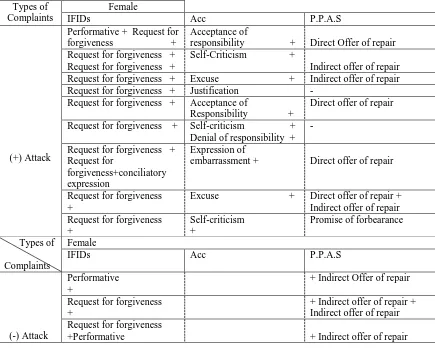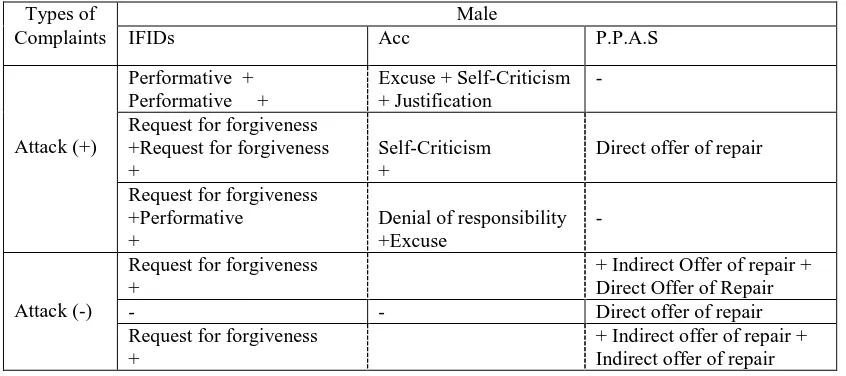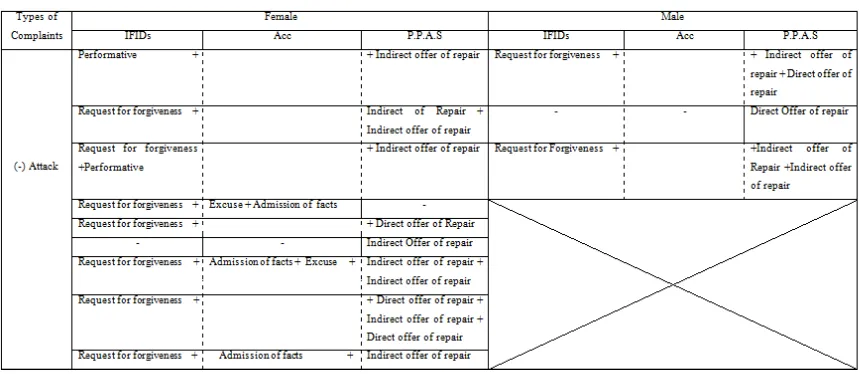THE APOLOGY STRATEGIES USED BY
A BUDGET HOTEL FRONT OFFICERS IN
HANDLING CUSTOMER COMPLAINTS
Talo, V.¹ and Mardijono, J. ²
¹˒² English Department, Faculty of Letters, Petra Christian University, Surabaya, East Java, Indonesia e-mails: vivere_talo@yahoo.com; josefa@peter.petra.ac.id.
ABSTRACT
This study focused on the use of apology strategies used by female and male front officers to reveal the types of apology strategies used and to reveal the similarities and differences between female and male front
officers’ way of apologizing in handling customer complaints. The types of apology strategies showed that both female and male front officers combined all three apology strategies which are IFIDs, Account and Positive Politeness Apology Strategies. Besides, the order of their use of apology strategies were also varied. However, the female front officers had more Positive politeness apology strategies when responding to complaints with attacks and the male front officer did not use Account strategy when handling customer complaints without attacks. Finally, it can be concluded that types of complaint play a more important role than gender factor in the use of apology strategies by these female and male front officers.
Keywords: Apology, Apology Strategies, Front Officers
In companies which deal with customers and sell services, the role of customer service is important. Customer service has the role as a bridge that connects the companies with their customers. When customers need information about the companies, their products, and their services, the customers usually deal with customer service. Besides, when customers complain about the given services, customer service will also be the one who responds and gives solution to the customers.
Hotels are one example of companies that deal a lot with customers and services. Thus, Customer service also has an important role in hotels. Customer service is the one that gives the first impression to the customers.
Although a hotel is very much concerned about customer satisfaction, customer complaints might happen in the hotel. If the services match customers’ expectations or even beyond the customers’ expectations, the customers will feel satisfied (Kotler and Amstrong, 2004). However, when the given services do not match with their expectations, customers may feel dissatisfied and complain to the customer service officers.
One of the hotel types that seem to be concerned about customers’ satisfaction is a budget hotel. A budget hotel is well known to have some service concepts or packages which are “low prices relative to other accommodation providers, a minimum of peripheral services, reduced contact with service personnel compared to other types of hotel accommodation, food and beverages may be severely restricted or even non-existent, and maintenance of certain features of the service package regardless of the physical location of a group budget hotel’s unit” (Brown et all, p. 95, 1991). Thus, it can be said that a budget hotel provides limited services. When the hotel services are limited, it can be said that a budget hotel may receive more customer complaints compared to luxurious hotels, hotels that provide good facilities and have expensive price.
One way to respond to a complaint is by using apology strategies, strategies used to fix an unpleasant situation. However, a complaint is not always followed by apology (Anna Trosborg, 1987). According to Eva Ogierman (2009), the present classification of apology strategies are divided into three main categories which are Illocutionary Force Indicating Devices or IFIDs, Accounts and Positive Politeness Apology Strategies.
male choose their words differently in interacting with people, it might affect their use of apology strategy when they respond to complaints. Therefore, it is important to find out the types of apology strategies used by the female and male front officers in handling customer complaints.
Apology Strategies
In complaint-apology situation there are three ‘Roles’ involved. The first is the complainer or the one who gives complaint, the second is the apologizer or the one who receives the complaint, and the third is a complaint or an expression of dissatisfaction. Eva Ogierman lists the apology strategies into three main categories which are Illocutionary Force Indicating Devices or IFIDs, Accounts and Positive Politeness Apology Strategies.
1. Illocutionary Force Indicating Devices (IFIDs)
This category was introduced as a technical term to refer to the category labeled ‘An Expression of Apology’ (Olsthain and Cohen’s speech act set, 1983:22 as cited at Ogierman 2009). Besides, IFIDs are highly routinised apology strategy. There are seven sub-categories of IFIDs. They are Performative, Offer of Apology, Request of Forgiveness, Expression of Regret, Conciliatory Expression, Disarming Softener, and Foreign Word.
2. Accounts
Accounts are defined as expressions reflecting the apologizer’s willingness to admit that he is responsible for the offensive outcome of the situation, whether or not they include reference to situations emphasizing, mitigating or denying the apologizer’s involvement in the offence. The classification of account types are Opt out, Denial of Responsibility, Acting Innocently, Minimisation, Excuse, Admission of Facts, Justification, Lack of Intent, Expression of Embarrassment, Acceptance of responsibility, and Self-Criticism.
3. Positive Politeness Apology Strategies
Positive politeness apology strategies concern about the apologizer’s and the complainer’s positive face needs with the purpose of restoring equilibrium and maintaining it in the future. There are three strategies that are under positive politeness apology strategies. The three strategies are Offer of Repair, Promise of Forbearance, and Concern for the hearer.
METHODS
This research utilized qualitative approach. The characteristics of the qualitative approach are the data analysis done with words; it describes social phenomena as they occur naturally, and it is an interpretive analysis (Dörnyei, 2007). In addition, the respondents are three female front officers and one male front officer, which was the total number of the front officers at the budget hotel.
The data were collected from the responses given by the front officers, through two different kinds of role-play situations. The responses are in the form of utterances.
Data Collection and Data Analysis
There were several steps to collect the data. First of all, I met the four front officers. Second, I asked them to read all the role-play situations clearly and I asked them to fill their responses toward the role-play situations in the form of utterances as naturally as possible. After that, I did the interview by asking all questions that I had made to all respondents, related to their complaint-apology situation that they just received recently. After that, I underlined which of the responses that were considered as apology strategies. Then, I divided the utterances based on the context or the topic.
Table 3.1 The Types of Apology Strategies Used by Female Front Officers
No. Utterances Complaint (+) Complaint (-) Apology Strategies Note IFIDs Acc P.P.A.S
Table 3.2 The Types of Apology Strategies Used by Male Front Officer
No. Utterances Complaint (+) Complaint (-) Apology Strategies Note IFIDs Acc P.P.A.S
Table 3.3 The Summary of Apology Strategies Used by Female And Male Front Officers.
Types of which can be summarized in the following table.
Table 1 The Types of Apology Strategies Used by Female Front Officers
Types of Request for forgiveness + Justification -
Request for forgiveness + Acceptance of
Responsibility +
embarrassment + Direct offer of repair
+
The types of apology strategies used by female front officers
First of all, I will discuss the types of apology strategies used by female front officers in handling customer complaints. There were three groups of responses from these female front officers when responding to complaints with attacks. The first group consists of a response that combined two different categories from IFIDs which were Request for forgiveness and Performative with other categories from Account and Positive politeness apology strategies. The strategy in the first group was:
- Perfromative + Request for forgiveness + Acceptance of responsibility+Direct offer of repair
The second group consists of responses which have three apology strategies (IFIDs, Account and Positive politeness apology strategies), and there were some repetitions of category from the same apology strategies. The strategies found at the second group were :
- Request for forgiveness + Request for forgiveness + Self-criticism + Indirect offer of repair
- Request for forgiveness + Request for forgiveness + Conciliatory expression + Expression of embarrasment + Direct offer of repair
The third group consists of responses that combined only one category from IFIDs which was request for forgiveness with other categories of apology strategies either from Account or Positive politeness apology strategies or even added with both Account and Positive politeness apology strategies. These are the strategies classified in the third group :
- Request for forgiveness + Excuse + Indirect offer of repair
- Request for forgiveness + Acceptance of responsibility + Direct offer of repair - Request for fogiveness + Excuse + Direct offer of repair
- Request for forgiveness + Self-criticism + Promise of forbearance - Request for forgiveness + Justification
- Request for frogiveness + Self-criticism + Denial of responsibility
The majority of responses from these female front officers when responding to complaint with attacks contained IFIDs, Account and Positive politeness strategies, even though the order of their categories of apology strategies were varied. In addition, there were only two responses found without Positive politeness apology strategies. Besides, Account strategies always occurred in the combination of their apology strategies in responding to complaints with attacks which mean they took on responsibility when the complainers attacked them directly.
On the other hand the types of apology strategies used by the female front officers when responding to complaints without attack can be classified into four groups. The first group consists of responses which only had categories from IFIDs and Positive politeness apology strategies.
- Performative + Indirect offer of repair
- Request for forgiveness + Direct offer of repair
- Request for forgiveness + Indirect offer of repair + Indirect offer of repair
- Request for forgiveness + Direct offer of repair + Inidrect offer of repair + Direct offer of repair
The second group consists of responses that have all three apology strategies (IFIDs, Account and Positive politeness apology strategies). One response in this second group was found to have repetition of category from the same apology strategies. One response in this second group was found to not only combine all three apology strategies, but also repeated the same category from the same apology strategies.
- Request for forgiveness + Admission of facts + Excuse + Indirect offer of repair + Indirect offer of repair
- Request for forgiveness + Admission of facts + Indirect offer of repair
The third group consists of one response which combined categories from IFIDs and Account.
- Request for forgiveness + Excuse + Admission of facts
The fourth group of responses contained a response which contained only one category from Positive politeness apology strategies. There was no repetition or combination found in this response. The response in the forth group consists of :
- Indirect offer of repair
Based on the result above, it is shown that the female front officers when responding to complaints without attack were more likely to reduce the involvement of their responsibilities. This can be seen from the occurance of Account strategies.
The Types of Apology Strategies Used by Male Front Officer
The next section will present the types of apology strategies used by the male front officers in handling customer complaints, which can be summarized in the following table.
Table 2 The Types of Apology Strategies Used by A Male Front Officer in Handling Customer Complaints
Types of
To start with, I will explain about the types of apology strategies used by the male front officer in handling customer complaints with attacks. There are two groups of responses. The first group consists of responses found to combine categories from IFIDs and Account.
- Performative + Performative + Excuse + Self-criticism + Justification - Request for forgiveness + Performative + Denial of responsibility
The second group consists of response that combined all three apology strategies (IFIDs, Account, and Positive politeness apology strategies).
- Request for forgiveness + Request for forgiveness + Self-criticism+ Direct offer of repair
When responding to customer complaints without attack, it can be seen that he did not combine all three apology strategies (IFIDs, Account, and Positive politeness apology strategies). There are two groups of responses. Here, the first group consists of responses that combined categories from IFIDs and Positive politeness apology strategies.
- Request for forgiveness + Indirect offer of repair + Direct offer of repair - Request for forgiveness + Indirect offer of repair + Indirect offer of repair
The second group of response found in the data consists of response that only use one category of apology strategies. The example of the response in the second group is :
- Indirect offer of repair
The result above shows that in responding to complaints without attacks, male front officer was not concerned about the involvement of responsibility. However, when combing IFIDs’ request for forgiveness and offer of repair from Positive politeness apology strategies, he showed his awareness of relationship between him and the complainer and his willingness to maintain his relationship with the complainer when responding to complaints without attacks.
After discussing the apology strategies that were used by the female and the male front officers in handling customer complaints, some similarities and differences were found in these front officers’ responses toward customer complaints whether the complainers directly attacked them or not.
The similarities and differences of apology strategies used by the female and male front officers
The next section will explain about the similarities and differences of apology strategies used by female and male front officers in handling customer complaints, summarized in the following table.
Comparing and contrasting the use of apology strategies by female and male front officers, I found two similarities related to the occurrence of Account strategies and IFIDs strategies in the combination of the responses when responding to complaints with attack.
First of all, it is clear that the majority of the responses from these front officers contained the combination of IFIDs, and Account when responding to customer complaints with attack. This shows that they did not only show their apology for platitude but also concerned about responsibility.
The last similarity found was the usage of Account category. Here, it can be seen that in responding to the complaints in which the complainers directly attacked the front officers, all of the responses contained Account strategies. This shows that both female and male front officers were concerned about whether to take or reduce the involvement of their responsibility when they were being complained due to their own mistakes.
Besides its similarities, I also found two differences between female and male front officers’ use of apology strategies in handling customer complaints with attacks.
First of all, it can be seen that the female front officers had more Positive politeness apology strategies than the male front officer. This might mean that the female front officers had more willingness to maintain their relationship with the complainers by giving compensation to fix the damages than male front officer.
The second difference found in the data was related to the variations in the combination of apology strategies. It can be seen in the data that there were repetitions of categories from the apology strategies used by the female front officers in handling customers occurred more than the variations of apology strategies used by male front officer.
The similarities found in the use of apology strategies between the female and the male front officers in responding to complaints without attacks were related to the occurrence of Positive politeness apology strategies in the combination of their apology strategies. The responses contained the sub-categories of offer of repair from positive politeness apology strategies which were Direct and Indirect offer of repair in all responses. This shows that these female and male front officers showed their willingness to fix the damages and wanted to maintain their relationship with the complainers by giving compensations that could be used to fix the damage even though they were not the ones who caused the damage.
male front officer did not use Account strategy when responding to complaints in which he was not directly attacked by the complainers. This shows that he was only concerned about his responsibility when the damages purely occurred because of him.
CONCLUSION
This research focused on the types of apology strategies used by female and male front officers at a budget hotel when handling customer complaints, to reveal the type of apology strategies used by female and male front officers and the similarities and or differences found in the use of apology strategies.
Firstly, the finding revealed that the majority of responses contained three main apology strategies (IFIDs, Account, Positive politeness apology strategies) in responding to customer complaints. However, the responses were found to have different combinations of apology strategies’ categories either from IFIDs, Account, or Positive politeness apology strategies. Secondly, the findings reviewed was male front officer, on the other hand was more likely to show his responsibility in an offensive situation in which he was involved in making the damage.
Even though this study compared the female and the male front officers in their use of apology strategies, it does not mean that it pictured all female and male front officers’ use of apology strategies due to the limited data. Further research can be done in a large number of female and male front officers. Hopefully, this study can be useful for readers who are interested in the use of apology strategies of hotel front officers when handling customer complaints.
REFERENCES
Brown, S. (Ed.), Gummerson, E., Edwardsson, B, & Gustavsson, B. (1991). Service quality: Multidiciplinary and multinational perspectives. NY:Macmillan,Inc.
Coulmas, F. (2005). Sociolingusitics the study of speaker’s choices. Cambridge: University Press.
Dörnyei, Z. (2007). Research methods in applied linguistics: Quantitative, qualitative, and mixed methodologies. Oxford: Oxford University Press
Kotler, P., & Armstrong, G (2004). Principles of marketing (10th ed.). Upper Saddle River, NJ: Pearson Education, Inc.
Ogierman, E. (2009) On apologising in negative and positive politeness cultures. Philadelphia:John Benjamins.


